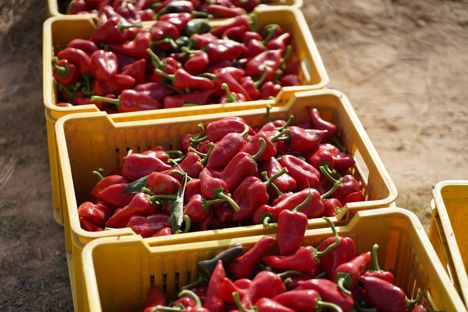
Ingredient Focus: piquillo peppers
Piquillo peppers may be sold in jars across the whole of Spain, yet the majority of them hail from the small town of Lodosa in Navarra. We find out more about the production and preparation of these sweet Spanish peppers.
Ingredient Focus: piquillo peppers
Piquillo peppers may be sold in jars across the whole of Spain, yet the majority of them hail from the small town of Lodosa in Navarra. We find out more about the production and preparation of these sweet Spanish peppers.
A small Navarran town on the banks of the Ebro River, Lodosa, despite having less than five thousand inhabitants, is well known throughout Spain for its roast piquillo peppers. The town, well aware of its claim to fame, seems to live the pepper, and bright red dried peppers tied together in strings hang out from almost every shop in the main street like year-round Christmas decorations.
Named piquillo after the small turned up point at the end of the pepper, piquillo peppers from Lodosa have had a geographic protection since 1986 which, as the current head of the PDO of piquillo pepper from Lodosa, farmer Jesus Aguirre explains, is a guarantee of quality for the end consumer. ‘Each pepper we pick’ he says standing in the middle of a field of mid-thigh height piquillo plants, ‘has to be a certain shape, colour and size or it doesn’t qualify as a piquillo from Lodosa.’
The piquillo plant is an herbaceous plant about half a metre high and the annual crop of peppers grow at different rates in layers up the entire height of the plant, meaning they’re harvested at different times. Planted as part of a crop rotation system, the piquillo plant lasts 2 years and then is replaced by other vegetables such tomato, artichoke or cauliflower and isn’t replanted on the same soil for another seven or eight years.
The fifth generation of fruit and vegetable farmers from Lodosa, it’s obvious that Jesus has farming in his blood and the affection with which he shows me the piquillo plants and points out his other crops is very touching. ‘None of this is easy,’ he says. ‘You really have to love doing this to work the land. You always have to be one step ahead planning crop cycle rotations, taking into account weather changes, pests, and all the unexpected.’
There are eight villages in total that can grow the protected status peppers, with Lodosa having the biggest population, and once picked, the peppers are always roasted as their thick skin makes them unsuitable for eating raw. Ever since they have been eaten, Lodosans have roasted and peeled the peppers and then households conserve them to eat all year round.
Roasting and preserving peppers as a business in Lodosa started in the sixties and seventies when Basques started visiting to buy the peppers. There are now twelve family run businesses making roasted PDO peppers. Conservas Perón on the main street in Lodosa only uses peppers from the family farm and have turned their tiny roasting factory into a tourist attraction with busloads of Spaniards visiting and buying on-site and then buying more online. At Perón they roast their peppers using wood fires with the entire process, from roasting to jarring, taking place in the one room, while the larger Conservas Pedro Luis use state of the art machinery and gas to roast and clean the peppers before they are jarred by hand.
The process that elevates piquillo peppers from Lodosa is that the raw peppers are cleaned, roasted and the skin is then peeled by hand. This gives piquillo peppers from Lodosa a unique depth of flavour. When you open a tin or a jar of PDO piquillo peppers, all the liquid in the jar comes from the pepper itself rather than being added water. This liquid is great for drizzling or for dipping bread in and is part of what makes the peppers such an exceptional product.
The peppers from Lodosa are normally stuffed with fish or meat and served in a tomato and piquillo sauce, although across Spain there is such an appreciation for them that nowadays they are also served warm and lightly confited in Extra Virgin olive oil and garlic. When served cold they can be stuffed with high quality ventresca tuna or served with anchovies. Whichever way you eat them, however you enjoy them, just remember that Lodosans call them red gold and when you have them, you’ll know why.

